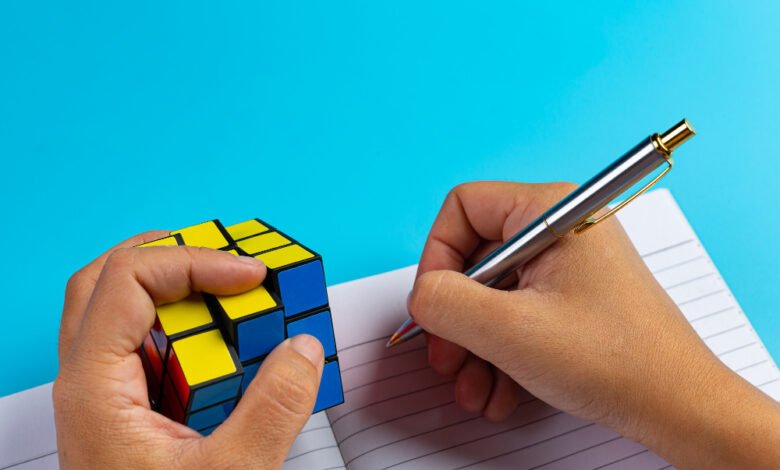
Solving a Rubik’s Cube is more than just a cool party trick—it’s a challenging yet rewarding puzzle that combines logic, spatial skills, and pattern recognition. Many people are fascinated by the art of solving the cube in the fastest time possible, and the secret lies in mastering specific Rubik’s cube tricks and algorithms. If you’re aiming to improve your speed-solving skills, understanding the best algorithms can significantly reduce your solve times. In this guide, we’ll explore the most important algorithms and Rubik’s cube tricks to help you achieve faster solves.
Understanding the Rubik’s Cube Basics
Before diving into the algorithms, it’s important to understand how a Rubik’s Cube works. The cube consists of three layers: the top layer, middle layer, and bottom layer. The goal is to solve the cube layer by layer, bringing all pieces of the same color together. The key to solving a Rubik’s Cube quickly is knowing the right sequences, or algorithms, to reposition pieces efficiently without disrupting the progress you’ve already made.
The Concept of Algorithms
In the context of solving a Rubik’s Cube, an algorithm is a sequence of moves that helps position specific pieces where they need to be, without altering other parts of the cube. By learning the correct algorithms, you can make solving the cube an intuitive process, instead of relying on trial and error.
1. CFOP Method: The Gold Standard of Speed-Solving
The CFOP Method (Cross, F2L, OLL, PLL) is the most popular technique among speed-cubers. It is broken into four main stages and includes a number of algorithms that make solving the cube much faster.
Cross
The first step in CFOP is creating a cross on one face of the cube. This means aligning the edge pieces with their corresponding center pieces, forming a plus sign. While there are no fixed algorithms for this step, practicing and recognizing the optimal moves will speed up this part of the solve.
F2L (First Two Layers)
The F2L step involves solving the first two layers simultaneously by pairing corner and edge pieces. There are over 40 different algorithms for F2L, but the key is to learn and recognize patterns to position these pieces efficiently. Mastering these algorithms is crucial for minimizing solve time and avoiding unnecessary moves.
OLL (Orientation of the Last Layer)
The OLL stage aims to orient all the pieces of the last layer so that they all face the same direction. There are 57 possible OLL algorithms, but many cubers start by learning just a few that are most commonly used. The OLL algorithms help you create a uniform color on the top layer, setting the cube up for the final solve.
PLL (Permutation of the Last Layer)
The final step is PLL, where you permute the pieces of the last layer until the entire cube is solved. There are 21 PLL algorithms, each dealing with a specific arrangement of corner and edge pieces. Knowing these algorithms is essential to complete the cube without having to use trial and error.
2. Advanced Algorithms: COL, ELL, and ZBLL
If you’re aiming for sub-10-second solve times, learning additional advanced Rubik’s cube tricks can be incredibly beneficial. These methods help reduce the number of moves and increase efficiency.
COL (Corner Orientation Last)
COL focuses on orienting the corner pieces in fewer steps. This set of algorithms can simplify the OLL process and is often used in conjunction with other methods to speed up the solve.
ELL (Edge Orientation Last)
ELL is similar to COL, but it involves orienting the edges during the OLL step. Learning ELL algorithms helps eliminate redundant moves and prepares the cube for a more seamless PLL.
ZBLL (Zborowski-Bruchem Last Layer)
ZBLL is a highly advanced method that combines OLL and PLL into one step. There are a total of 493 algorithms for ZBLL, but knowing even a few of these can drastically reduce solve times. ZBLL is ideal for advanced cubers looking to push their solving limits.
3. Two-Look OLL and PLL: A Simplified Approach
For those who are still in the learning phase or are overwhelmed by the number of algorithms in CFOP, Two-Look OLL and Two-Look PLL offer a simpler alternative. This method breaks down OLL and PLL into multiple steps, reducing the number of algorithms you need to memorize while still allowing you to solve the cube effectively.
Two-Look OLL
With Two-Look OLL, you use a small set of algorithms to first orient the edges and then orient the corners. This approach involves learning around 10 algorithms, making it a simpler way to tackle the last layer.
Two-Look PLL
Two-Look PLL involves two steps: permuting the corners and then permuting the edges. With around 6-8 algorithms to learn, this is a manageable way to solve the final layer without needing to memorize all 21 PLL algorithms.
4. Roux Method: An Alternative to CFOP
The Roux Method is another popular method for solving the Rubik’s Cube. It is based on block-building and is a great alternative to CFOP for those who prefer fewer algorithms and more intuitive solving.
First Block and Second Block
The Roux Method starts by building two 1x2x3 blocks on one side of the cube. This approach is intuitive and requires fewer algorithms than CFOP, making it ideal for those who prefer a more visual solving style.
CMLL (Corner Orientation and Permutation)
After building the blocks, the CMLL step is used to solve the corners of the last layer. There are 42 CMLL algorithms, which focus on both orienting and permuting the corners simultaneously.
L6E (Last Six Edges)
The final step of the Roux Method is solving the remaining six edges. This step is usually intuitive, and advanced solvers learn specific algorithms to optimize it.
5. Tips for Memorizing Algorithms
Learning algorithms for Rubik’s cube tricks can be challenging, but breaking them down into smaller parts and practicing regularly will make it easier over time. Here are some tips for mastering algorithms:
Practice in Small Sections
Don’t overwhelm yourself by trying to learn multiple algorithms at once. Focus on one algorithm or step at a time until you can execute it flawlessly.
Use Flashcards
Create flashcards with the algorithms on one side and visual diagrams on the other. This method helps reinforce memorization and makes learning more interactive.
Drill Each Algorithm
Repetition is key when learning Rubik’s cube tricks. Spend time drilling each algorithm until it becomes muscle memory. The more familiar you are with each move sequence, the faster and more fluidly you’ll be able to solve the cube.
Group Similar Algorithms Together
Many OLL and PLL algorithms have similarities. By grouping similar algorithms, you can spot patterns that will make them easier to remember.
6. Common Rubik’s Cube Tricks for Faster Solving
Finger Tricks
Finger tricks are techniques used to manipulate the cube with minimal movement of the wrists and arms, allowing for faster turning. Learning efficient finger tricks can drastically reduce your solve time by making each move faster and smoother.
Look-Ahead
Look-ahead is a skill that involves planning your next move while executing the current one. This is a crucial aspect of speed-solving, as it reduces the amount of time spent thinking between moves. Practicing look-ahead will help you transition seamlessly from one step to the next.
Cube Rotation Minimization
Minimizing cube rotations is another way to improve solving speed. Unnecessary rotations can add precious seconds to your solve time. Learn to execute algorithms with minimal cube rotations to maintain your flow.
7. Latest Trends in Speed-Cubing
Magnetic Cubes
Magnetic cubes are a recent innovation that has taken the speed-cubing world by storm. These cubes contain small magnets that help align the layers more precisely, allowing for faster and more controlled turning. Many top cubers are now using magnetic cubes for their added stability.
Smart Cubes
Smart cubes are Bluetooth-enabled cubes that connect to a smartphone app, providing real-time feedback on your solving technique. These cubes are great for tracking your progress, analyzing your moves, and identifying areas where you can improve.
Online Competitions
With the rise of virtual competitions, speed-cubing has become more accessible to everyone. Participating in online competitions is a great way to challenge yourself, learn from others, and stay motivated in your journey to mastering Rubik’s cube tricks.
Conclusion
Mastering the best algorithms is key to improving your Rubik’s Cube solving speed. Whether you choose to focus on the CFOP Method, Roux Method, or advanced Rubik’s cube tricks like ZBLL, the path to faster solving times involves consistent practice, a strong understanding of algorithms, and effective memorization techniques. By combining these elements, you can drastically reduce your solve times and achieve new personal bests.
Remember, speed-solving is a journey that requires patience and dedication. Start by mastering the basic algorithms, practice regularly, and incorporate advanced techniques as you become more comfortable. With time and effort, you’ll be able to impress friends and family with your lightning-fast Rubik’s Cube solving skills and become a true master of the cube.

